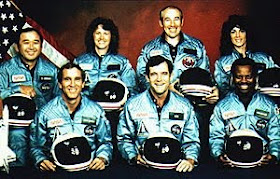 Today marks the 25th anniversary of the Space Shuttle Challenger disaster, in which the mission's seven crew members had been killed after the shuttle broke apart over the Atlantic Ocean 73 seconds into the flight.
Today marks the 25th anniversary of the Space Shuttle Challenger disaster, in which the mission's seven crew members had been killed after the shuttle broke apart over the Atlantic Ocean 73 seconds into the flight.According to the Report of the Presidential Commission on the Space Shuttle Challenger Accident, weather conditions were likely 1 of the factors that contributed to the incident.
STS-51-L was the 25th American Space Shuttle Program flight. It was also the first mission to have a civilian on board, American teacher Sharon Christa McAuliffe.
The Report of the Presidential Commission on the Space Shuttle Challenger Accident stated the cause of the loss was a failure of the right Solid Rocket Booster, or SRB. SRBs are positioned to the right and left of the shuttle to assist thrust the orbiter into space.
More specifically, a seal created to stop gasses from leaking throughout liftoff failed. This seal is an O-ring made of a kind of rubber that is designed to keep a joint in the booster sealed.
As soon as the seal failed, hot gas started to leak from it, which can be observed in video footage of the launch.
As the shuttle ascended within the atmosphere, it encountered expected high-altitude wind shear conditions that lasted for about 30 seconds of the flight. These wind shear conditions had been sensed and countered by the navigation, control and guidance systems.
However, the leak led to an eventual structural failure of the external tank. When the tank failed, the orbiter broke up. Contrary to well-liked belief, the shuttle did not explode, but rather disintegrated due to aerodynamics.
The commission determined in its findings that a faulty style "unacceptably sensitive to numerous factors" was to blame. These factors included the materials used, physical dimensions, and also the temperature conditions.
Based on the report, "The weather was forecast to be clear and cold, with temperatures dropping into the low 20s overnight."
Melbourne, Fla., situated about 35 miles from Cape Canaveral, recorded a record low temperature of 26 degrees; the regular low on Jan. 28 is 50 degrees.
Likewise, Orlando also had a record low of 26 degrees that morning. Each records still stand, and each locations broke their record lows the following morning as well.
As a outcome of the cold, gusty winds, ice accumulated on the launch pad area overnight. The ice was eliminated by crews, and several ice checks took location prior to launch.
According to the report, the air temperature at the time of launch, 11:38 a.m. EST, was 36 degrees. This temperature was 15 degrees colder than any prior launch.
A written recommendation existed advising against a launch at temperatures beneath 53 degrees for fear of O-ring and joint failure, based on the report, but those in charge of making the decision to launch were not conscious of it.
The report continues, "If the decision-makers had known all of the details, it's highly unlikely that they would have decided to launch 51-L on Jan. 28, 1986."
A house video recording of the incident from a backyard in central Florida shows covered bushes, most likely done to prevent frost harm.
"That's a historical second we got on tape, I guess," Jack Moss, who was filming, said just before he turned the camera off.
Tidak ada komentar:
Posting Komentar